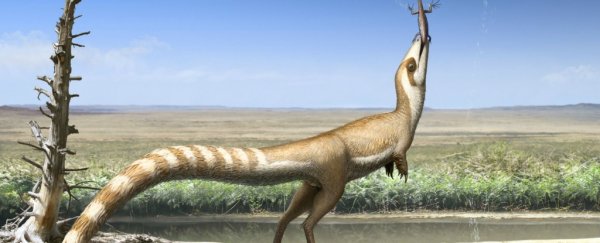The first feathered dinosaur ever found is still spilling its secrets. Sinosauropteryx was uncovered two decades ago, when a farmer in northeastern China unearthed a remarkable fossil while digging a well.
The dinosaur's ancient feathery fluff stunned experts and helped cement the idea that birds are living, avian dinosaurs.
Paleontologists continue to wring new and unusual details from Sinosauropteryx remains - like the brown mark streaked over its snout from its eyes to cheeks, much like the bandit mask on a raccoon.
No other known dinosaur fossil shows a bandit mask, according to the team of researchers at England's University of Bristol, who recently analysed two specimens.
The scientists also determined that the animal was camouflaged: Its belly was light and its back was dark, a pattern to disguise the four-foot-long creature from carnivores.
 Robert Nicholls
Robert Nicholls
Bandit masks in mammals tend to be warnings. University of Bristol paleobiologist Jakob Vinther, author of a paper published Thursday in the journal Current Biology, said face stripes are common among "mid-level" predators such as badgers and raccoons.
"It shows you shouldn't mess with them," he said. "But we don't think that's the main function in Sinosauropteryx."
At just under six pounds, about the weight of a chihuahua, the dinosaur would not have been a major threat. It's also possible that its face stripes served to cut glare from the sun, like the black grease beneath a football player's eyes.
Wood frogs and small birds, such as the yellowthroat warbler, also have masklike splotches.
"There's no reason why a pattern might not have multiple functions," Vinther noted. He said he wouldn't be surprised if other dinosaurs had similar marks - it's just that no one has found them yet.
Li Yinfang, the fortunate farmer in China's Liaoning province, plucked the dinosaur from the ghost of a lake that existed about 120 million years ago.
Yinfang's discovery triggered a dino gold rush - the area is now cratered with holes made by other young men hoping to find similarly valuable remains, Vinther said. (An exceptional fossil can be the ticket to buying a farm, which also improves a man's eligibility as a bachelor, he explained.)
Once in the hands of paleontologists, the well-preserved fossil caused a scientific ruckus. "When I saw this slab of silt stone mixed with volcanic ash in which the creature is embedded, I was bowled over," dinosaur researcher Philip J. Currie told the New York Times in 1996.
Currie brought photographs of Sinosauropteryx from China to a meeting at the American Museum of Natural History in New York, where experts crowded around the pictures to glimpse the Cretaceous dinosaur covered in fluff, the Times reported.
Above: A fossil specimen of Sinosauropteryx from the Early Cretaceous and an interpretive drawing of the bones, stomach contents and darkly pigmented feathers.
The dinosaur did not have proper plumage but unsophisticated bristles that paleontologists call proto-feathers. In 2010, researchers teased the first hints of colour from protein sacs embedded in the fossilised skin bits and those bristles.
In the latest work, Vinther and his colleagues used high-tech photography to image the dinosaur remains, blocking out all incoming glare, and set to work analysing the creature's colors.
Not only did they find the bandit mask, but their work revealed a form of camouflage colors called counter-shading (so called, as Vinther said, because it literally counteracts shadows).
The dark brown on its back and the white on its belly would have obscured the animal's outline, making Sinosauropteryx more difficult to spot in the sunlight.
The paleontologists 3D-printed a mock Sinosauropteryx and set about placing the model dinosaur in various environments. Its colors were most effective in open prairies or savannas and less effective in wooded regions.
In that regard, Sinosauropteryx resembled a pronghorn antelope, a prairie animal, rather than a forest creature like a white-tailed deer.
Sinosauropteryx joins a small but growing group of dinosaurs discovered to have camouflage. A huge herbivore, called a nodosaur, also was countershaded.
It had dark red pigment on its back and lighter colors on its stomach, paleontologists reported in August. Even those massive animals had to hide from the hungry carnivores that stomped through the Cretaceous Period 100 million years ago.
Uncovering dinosaur colors doesn't simply mean that paleontologic art will be more realistic. "Using camouflage patterns, we can say which dinosaurs lived where," Vinther said, "to paint a more complete picture of how the landscape looked like back then."
Sinosauropteryx remains have been found next to woodland dinosaurs. But Vinther said this research suggests that these animals probably never met while alive - rather, their bodies were swept together, and their proximity is an artifact of lake-bed fossilisation.
"We're demystifying the dinosaurs. They didn't look wild and wonky," Vinther said.
Many species alive today are countershaded: not just pronghorn antelope but also squirrels and coyotes. And many animals, too, have coats of brown or white, the better to hide.
Colorful birds are a minority, Vinther said, which is why he isn't surprised that scientists have yet to find many bright pink or orange dinosaurs.
After all, dazzling songbirds have a crucial advantage over other dinosaurs: flight. Fluff is no help when camouflage fails. The only other option for Sinosauropteryx was to run.
2017 © The Washington Post
This article was originally published by The Washington Post.

